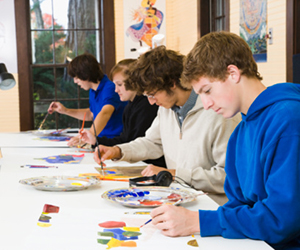Learned Creativity — How to Innovate in the Classroom

When people think of innovative organizations, they may first jump to the business and technology fields. In the field of education, however, new governmental standards and reforms, as well as growing competition for resources and students, has made innovation increasingly important.
Although innovation has increasingly become vital, not all organizations — schools included — have the same level of creative output. In a 2014 article published in the European Journal of Work Psychology, researchers Anna R. Koch (University of Muenster, Germany), Carmen Binnewies (University of Muenster, Germany), and Christian Dormann (University of Mainz, Germany), examine the role that school principals play in fostering the creativity of teachers and their schools’ innovative output.
Because principals and teachers work in close proximity, it is only natural that the behavior of one might influence the other. Principals who are engaged in their work, show creativity, demonstrate that going the extra mile is worthwhile, and encourage similar attitudes in their teachers. They also promote a climate where teachers feel hard work and creative initiative are core values that have long-reaching, positive consequences for their students.
Teachers’ increased creativity should in turn foster innovative behavior in the entire school. Teachers are the main initiators of action within a school; when they pursue creativity, they produce more innovative ideas and often develop better plans for implementing the ideas they generate. Schools with more creative teachers end up having a large number of well-planned ideas to choose from, increasing the likelihood that their innovative output will be high.
To examine these hypotheses — that principals’ work engagement influences teacher creativity, and in turn school innovation — the researchers collected data from 87 principals and 902 teachers working at 83 German schools. The schools were a mix of junior high schools, high schools, vocational schools, and schools for people with special needs.
Principals rated their levels of work engagement, and teachers rated their creativity and their schools’ innovation using short self-report surveys. In addition to self-report measures, the researchers collected several objective measures of school innovation. Independent raters examined the number of school projects reported on the school’s website (e.g., excursions, student exchanges, and external cooperation with local companies that allow students to interact beyond the classroom), and the design of external (i.e., prospective students and their parents) and internal (i.e., current students and teachers) communication information provided on the school’s website.
The researchers used multilevel structural equation modeling to test the relationships among principals, teachers, and school innovation, finding that principals’ work engagement predicted teachers’ creative idea generation at both the individual and the school levels. Teachers’ idea generation at the school level, in turn, was found to predict the objective measures of innovation (i.e., school projects, external communication, and internal communication). In general, the researchers’ hypotheses about the impact of principals on teacher creativity and school innovation were supported — that principals’ work motivation leads to increased teacher creativity, which results in greater innovative output for the school.
Based on these findings, the researchers suggest that principals be given more latitude for decision-making and perhaps be provided with training sessions to help them become more positive, prepared, and self-sufficient leaders. Opportunities for interaction between principals and teachers also are suggested to help facilitate greater creativity and school innovation.
Although this research was conducted in a school setting, the researchers believe the findings have implications for other organizations wishing to boost innovation — especially those with a similar hierarchical structure.
Reference
Koch, A. R., Binnewies, C., & Dormann, C. (2015). Motivating innovation in schools: School principals’ work engagement as a motivator for schools’ innovation. European Journal of Work and Organizational Psychology, 24, 505–517. doi: 10.1080/1359432X.2014.958471





APS regularly opens certain online articles for discussion on our website. Effective February 2021, you must be a logged-in APS member to post comments. By posting a comment, you agree to our Community Guidelines and the display of your profile information, including your name and affiliation. Any opinions, findings, conclusions, or recommendations present in article comments are those of the writers and do not necessarily reflect the views of APS or the article’s author. For more information, please see our Community Guidelines.
Please login with your APS account to comment.